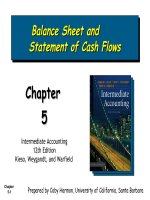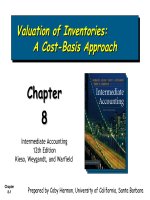Intermediate accounting 12th edition kieso warfield chapter 15
Bạn đang xem bản rút gọn của tài liệu. Xem và tải ngay bản đầy đủ của tài liệu tại đây (486.71 KB, 54 trang )
Stockholders’
Stockholders’ Equity
Equity
Chapter
15
Intermediate Accounting
12th Edition
Kieso, Weygandt, and Warfield
Chapter
15-1
Prepared by Coby Harmon, University of California, Santa Barbara
Learning
Learning Objectives
Objectives
1.
Discuss the characteristics of the corporate form of
organization.
2.
Identify the key components of stockholders’ equity.
3.
Explain the accounting procedures for issuing shares of stock.
4.
Describe the accounting for treasury stock.
5.
Explain the accounting for and reporting of preferred stock.
6.
Describe the policies used in distributing dividends.
7.
Identify the various forms of dividend distributions.
8.
Explain the accounting for small and large stock dividends, and
for stock splits.
9.
Indicate how to present and analyze stockholders’ equity.
Chapter
15-2
Stockholders’
Stockholders’ Equity
Equity
The Corporate
Form
State
corporate law
Capital stock
or share
system
Variety of
ownership
interests
Chapter
15-3
Corporate
Capital
Preferred
Stock
Dividend
Policy
Presentation
and Analysis
Issuance of
stock
Reacquisition
of shares
Features
Accounting
for and
reporting
preferred
stock
Financial
condition and
dividend
distributions
Types of
dividends
Stock split
Presentation
Analysis
Disclosure of
restrictions
The
The Corporate
Corporate Form
Form of
of Organization
Organization
Three primary forms of business organization
Proprietorship
Partnership
Corporation
Special characteristics of the corporate form:
1. Influence of state corporate law.
2. Use of capital stock or share system.
3. Development of a variety of ownership interests.
Chapter
15-4
LO 1 Discuss the characteristics of the corporate form of organization.
The
The Corporate
Corporate Form
Form of
of Organization
Organization
State Corporate Law
Corporation must submit articles of incorporation
to the state in which incorporation is desired.
General Motors - incorporated in Delaware.
U.S. Steel - incorporated in New Jersey.
Accounting for stockholders’ equity follows the
provisions of each states business incorporation act.
Chapter
15-5
LO 1 Discuss the characteristics of the corporate form of organization.
The
The Corporate
Corporate Form
Form of
of Organization
Organization
Capital Stock or Share System
In the absence of restrictive provisions, each share
carries the following rights:
1. To share proportionately in profits and losses.
2. To share proportionately in management (the right
to vote for directors).
3. To share proportionately in assets upon liquidation.
4. To share proportionately in any new issues of stock
of the same class—called the preemptive right.
Chapter
15-6
LO 1 Discuss the characteristics of the corporate form of organization.
The
The Corporate
Corporate Form
Form of
of Organization
Organization
Variety of Ownership Interests
Common stock represents basic ownership interest.
Bears ultimate risks of loss.
Receives the benefits of success.
Not guaranteed dividends nor assets upon
dissolution.
Preferred stock is created by contract, when
stockholders’ sacrifice certain rights in return for
other rights or privileges, usually dividend preference.
Chapter
15-7
LO 1 Discuss the characteristics of the corporate form of organization.
Corporate
Corporate Capital
Capital
Contributed
Contributed
Capital
Capital
Common
CommonStock
Stock
Account
Account
Preferred
PreferredStock
Stock
Additional
AdditionalPaidPaidininCapital
Capital
Account
Account
Account
Account
Two Primary
Sources of
Equity
Retained
RetainedEarnings
Earnings
Account
Account
Less:
Less:
Treasury
TreasuryStock
Stock
Assets –
Liabilities =
Equity
Account
Account
Chapter
15-8
LO 2 Identify the key components of stockholders’ equity.
Corporate
Corporate Capital
Capital
Issuance of Stock
Shares authorized - Shares sold - Shares issued
Accounting problems:
1. Par value stock.
2. No-par stock.
3. Stock issued with other securities.
4. Stock issued in noncash transactions.
5. Costs of issuing stock.
Chapter
15-9
LO 3 Explain the accounting procedures for issuing shares of stock.
Corporate
Corporate Capital
Capital
Par Value Stock
Low par values help companies avoid a contingent
liability.
Corporations maintain accounts for:
Preferred Stock or Common Stock.
Additional Paid-in Capital
Chapter
15-10
LO 3 Explain the accounting procedures for issuing shares of stock.
Corporate
Corporate Capital
Capital
BE15-1: Lost Vikings Corporation issued 300
shares of $10 par value common stock for $4,100.
Prepare Lost Vikings’ journal entry.
Journal entry:
Cash
Chapter
15-11
4,100
Common stock (300 x $10)
3,000
Additional paid-in capital
1,100
LO 3 Explain the accounting procedures for issuing shares of stock.
Corporate
Corporate Capital
Capital
No-Par Stock
Reasons for issuance:
Avoids contingent liability.
Avoids confusion over recording par value
versus fair market value.
Some states require that no-par stock have a
stated value.
Chapter
15-12
LO 3 Explain the accounting procedures for issuing shares of stock.
Corporate
Corporate Capital
Capital
BE15-2: Shinobi Corporation issued 600 shares of nopar common stock for $10,200. Prepare Shinobi’s journal
entry if (a) the stock has no stated value, and (b) the
stock has a stated value of $2 per share.
Journal entry:
a. Cash
10,200
Common stock
10,200
b. Cash
Chapter
15-13
10,200
Common stock (600 x $2)
1,200
Additional paid-in capital
9,000
LO 3 Explain the accounting procedures for issuing shares of stock.
Corporate
Corporate Capital
Capital
Stock Issued with Other Securities
Two methods of allocating proceeds:
1. the proportional method and
2. the incremental method.
Chapter
15-14
LO 3 Explain the accounting procedures for issuing shares of stock.
Corporate
Corporate Capital
Capital
BE15-4: Primal Rage Corporation issued 300 shares of $10
par value common stock and 100 shares of $50 par value
preferred stock for a lump sum of $14,200. The common
stock has a market value of $20 per share, and the preferred
stock has a market value of $90 per share.
Common stock
Preferred stock
Allocation:
Issue price
Allocation %
Total
Chapter
15-15
Number
300
100
Common
$ 14,200
40%
$
5,680
Amount
Total
x $
20.00 = $ 6,000
x
90.00
9,000
Fair Market Value $ 15,000
Preferred
$
14,200
60%
$
8,520
Percent
40%
60%
100%
Proportional
Method
LO 3 Explain the accounting procedures for issuing shares of stock.
Corporate
Corporate Capital
Capital
BE15-4: Primal Rage Corporation issued 300 shares of $10
par value common stock and 100 shares of $50 par value
preferred stock for a lump sum of $14,200. The common
stock has a market value of $20 per share, and the preferred
stock has a market value of $90 per share.
Journal entry (Proportional):
Cash
Chapter
15-16
14,200
Preferred stock (100 x $50)
5,000
Additional paid-in capital-preferred
3,520
Common stock (300 x $10)
3,000
Additional paid-in capital-common
2,680
LO 3 Explain the accounting procedures for issuing shares of stock.
Corporate
Corporate Capital
Capital
BE15-4: (Variation) Primal Rage Corporation issued 300
shares of $10 par value common stock and 100 shares of $50
par value preferred stock for a lump sum of $14,200. The
common stock has a market value of $20 per share, and the
value of the preferred stock is unknown.
Common stock
Preferred stock
Allocation:
Issue price
Common
Total
Chapter
15-17
Number
300
100
Common
$
6,000
Amount
Total
x $
20.00 = $ 6,000
x
Fair Market Value $ 6,000
Preferred
$
14,200
(6,000)
$
8,200
Incremental
Method
LO 3 Explain the accounting procedures for issuing shares of stock.
Corporate
Corporate Capital
Capital
BE15-4: (Variation) Primal Rage Corporation issued 300
shares of $10 par value common stock and 100 shares of $50
par value preferred stock for a lump sum of $14,200. The
common stock has a market value of $20 per share, and the
value of the preferred stock is unknown.
Journal entry (Incremental):
Cash
Chapter
15-18
14,200
Preferred stock (100 x $50)
5,000
Additional paid-in capital-preferred
3,200
Common stock (300 x $10)
3,000
Additional paid-in capital-common
3,000
LO 3 Explain the accounting procedures for issuing shares of stock.
Corporate
Corporate Capital
Capital
Stock Issued in Noncash Transactions
The general rule: Companies should record
stock issued for services or property other
than cash at either the:
fair value of the stock issued or
fair value of the noncash consideration
received,
whichever is more clearly determinable.
Chapter
15-19
LO 3 Explain the accounting procedures for issuing shares of stock.
Corporate
Corporate Capital
Capital
E15-2: Kathleen Battle Corporation was organized on
January 1, 2007. It is authorized to issue 500,000 shares
of no par common stock with a stated value of $1 per
share. Prepare the journal entry to record the following.
April 1 Issued 24,000 shares of common stock for land.
The asking price of the land was $90,000; the fair market
value of the land was $80,000.
Land
Chapter
15-20
80,000
Common stock (24,000 x $1)
24,000
Additional paid-in capital
56,000
LO 3 Explain the accounting procedures for issuing shares of stock.
Corporate
Corporate Capital
Capital
E15-2: Kathleen Battle Corporation was organized on
January 1, 2007. It is authorized to issue 500,000 shares
of no par common stock with a stated value of $1 per
share. Prepare the journal entry to record the following.
Aug. 1 Issued 10,000 shares of common stock to attorneys
in payment of their bill of $50,000 for services rendered in
helping the company organize.
Organization expense
Chapter
15-21
50,000
Common stock (10,000 x $1)
10,000
Additional paid-in capital
40,000
LO 3 Explain the accounting procedures for issuing shares of stock.
Corporate
Corporate Capital
Capital
Costs of Issuing Stock
Direct costs incurred to sell stock, such as
underwriting costs,
accounting and legal fees,
printing costs, and
taxes,
should be reported as a reduction of the
amounts paid in (additional paid-in capital).
Chapter
15-22
LO 3 Explain the accounting procedures for issuing shares of stock.
Corporate
Corporate Capital
Capital
Reacquisition of Shares
Corporations purchase their outstanding stock:
To provide tax-efficient distributions of excess
cash to shareholders.
To increase earnings per share and return on equity.
To provide stock for employee stock compensation
contracts or to meet potential merger needs.
To thwart takeover attempts or to reduce the
number of stockholders.
To make a market in the stock.
Chapter
15-23
LO 4 Describe the accounting for treasury stock.
Corporate
Corporate Capital
Capital
Purchase of Treasury Stock
Two acceptable methods:
Cost method (more widely used).
Par or Stated value method.
Treasury stock, reduces stockholders’ equity.
Chapter
15-24
LO 4 Describe the accounting for treasury stock.
Corporate
Corporate Capital
Capital
Illustration: UC Company originally issued 15,000 shares
of $1 par, common stock for $25 per share. Record the
journal entry for the following transaction:
April 1st the company re-acquired 1,000 shares for $28
per share.
Treasury stock (1,000 x $28)
Cash
Chapter
15-25
28,000
28,000
LO 4 Describe the accounting for treasury stock.









